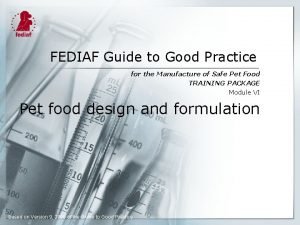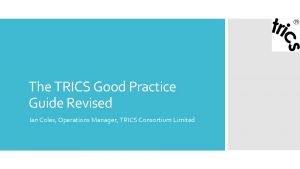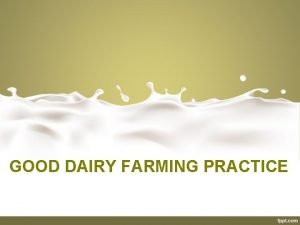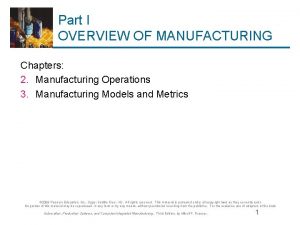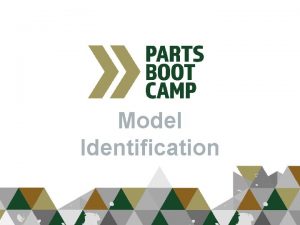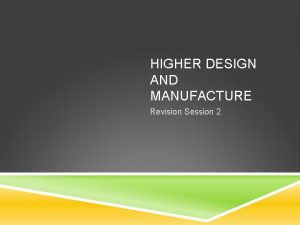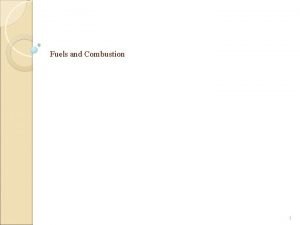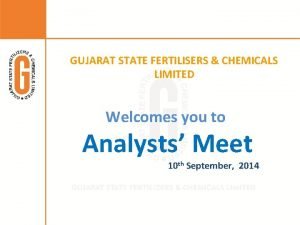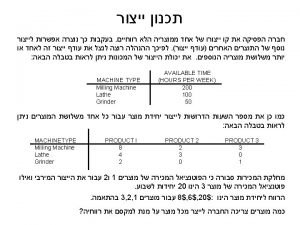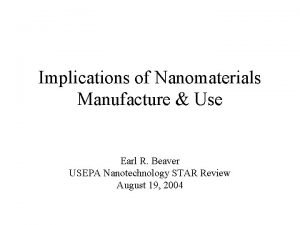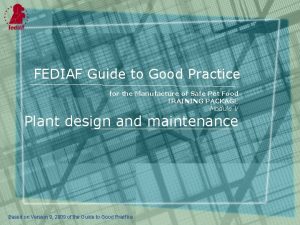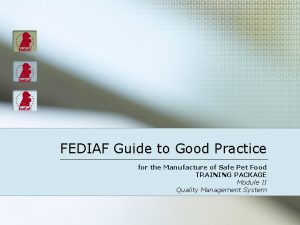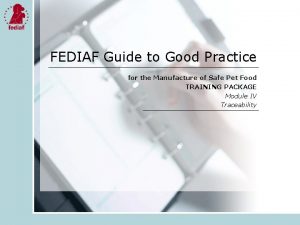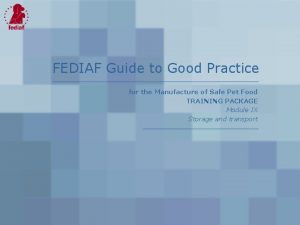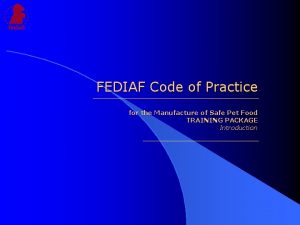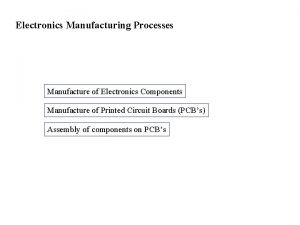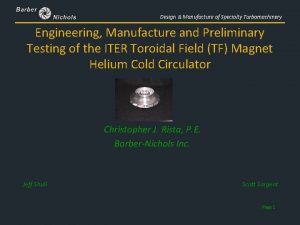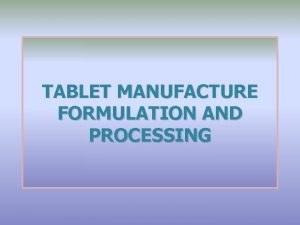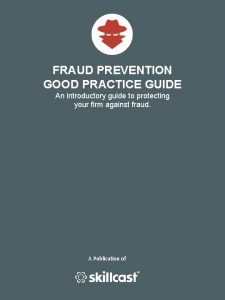FEDIAF Guide to Good Practice for the Manufacture


















- Slides: 18

FEDIAF Guide to Good Practice for the Manufacture of Safe Pet Food TRAINING PACKAGE Module III Hazard Analysis and Critical Control Points

Food Safety Management System CI Review measure HACCP Food safety management Prerequisites (GMP)

Food Safety Management System Food safety management system consists of a prerequisite programme and a HACCP system Senior management commitment as first condition Components of the HACCP system: § Implemented within the quality management system § HACCP team leader and personnel trained and skilled § Specific to the application, practical and effective § Reviewed regularly and validated § CCPs and OPRPs identified, controlled, monitored and recorded

Pre-Requisite Programmes Prerequisite programmes are basic conditions and activities (good practices) Examples: Ø Ø Ø Ø Ø Exterior/Interior conditions Cleaning Storage conditions Handling of toxic materials Training Pest control Calibration Supplier control Good Laboratory Practice etc Food and Non food grade Lubricant storage Calibration status

3. HACCP - definitions What is HACCP? Hazard Analysis and Critical Control Points is a technique that identifies, evaluates and controls hazards significant for food safety What is a hazard? A biological, chemical or physical agent in, or condition of, food or feed with the potential to cause an adverse health effect What is pet food safety? Assurance that, when eaten according to its intended use, the pet food will not harm the animal

Examples of food borne hazards Bacteria: Aeromonas, Clostridium perfrigens, Clostridium botulinum, Campyloabcter, pathogenic E. coli, Listeria monocytogenes, Salmonella, Staphylococcus aureus… Viruses: Hepatitis A, Rotavirus, Norwalk-like viruses… Physical: Metal, Glass… Parasites: Chemicals: PCBs, Dioxins, Heavy metals, Pesticides, Veterinary Drugs, Mycotoxins, Melamine, Toxins… Trichinella spiralis, Taenia, Fasciola hepatica…

Ex. : decision tree to determine inspection plans based on the source Feed material/Ingredient/ Additive/packaging/Wet product/Finished Products Trader does not separate supplies Is your supplier a trader? yes Trader separates supplies no EU/EFTA origin or of third country with equivalent safety/hygiene standards? Third country origin with occurrence or doubts as to safety/hygiene concerns? Does supplier has the quality assurance system in place ? no yes Follow frequency for Low Risk ( A) yes no Follow frequency for Medium Risk ( B) Follow frequency for High Risk (C)

HACCP principles Step 0 Implement Pre-requisite Programmes Conduct a hazard analysis Assemble HACCP Team Describe product Identify intended use Construct Flow diagram Confirm flow diagram on site List all potential hazards Conduct a hazard analysis Consider control measures Determine the Critical Control Points (CCPs) and Operational Pre-Requisite Programs (OPRPs) Use decision tree to determine CCPs and OPRP’s Establish critical limits Establish action and critical limits for each CCP and OPRP Establish CCP monitoring procedures Establish monitoring systems for each CCP and OPRP Establish corrective action plans Establish the corrective action to be taken when monitoring indicates that a particular CCP or OPRP is not under control Establish verification procedures Establish procedures for verification to confirm that the HACCP system is working effectively Establish documentation and recordkeeping systems Establish documentation concerning all procedures and records appropriate to these principles and their application Establish Validation of control measures Codex Principle 1 Codex Principle 2 Codex Principle 3 Codex Principle 4 Codex Principle 5 Codex Principle 6 Codex Principle 7

HACCP study What is a risk? Probability of causing an adverse health effect caused by the occurrence and severity of a hazard in food Risk assessment to identify hazards: § Occurrence/severity of hazards and adverse effects § Qualify/quantify hazards § Micro-organisms growth § Toxins, chemicals or physical agents § Conditions leading to the above Clostridium botulinum

Ex. : decision tree to identify CCPs and OPRPs (1) Q 1 Do preventative control measure(s) exist for the identified hazard (including control measures upstream)? Yes No Modify steps in the process or product Is control at this step necessary for safety? No Q 2 Yes Not a CCP Is the step specifically designed and essential to eliminate or reduce the likely occurrence of a hazard to an acceptable level by it self? No No Q 3 Point, step or procedure at which control can be applied and is essential to prevent or eliminate hazards or reduce it to an acceptable level Stop* Yes Is control measure at this step essential, in combination with other control measures, but of control does not automatically implicate there is an immediate food safety risk? Is the step specifically designed to eliminate or reduce the likely occurrence of a hazard to an acceptable level? Critical Control Point OPRP

Ex. : decision tree to identify CCPs and OPRPs (2) Q 3 Point, step or procedure at which control can be applied and is essential to prevent or eliminate hazards or reduce it to an acceptable level Could contamination occur, with identified hazard(s) in excess of acceptable level(s), or could this increase to unacceptable levels? Yes Q 4 No Not a CCP Stop* Will a subsequent step eliminate identified hazard(s) or reduce likely occurrence to acceptable levels? Yes OPRP No Critical Control Point

HACCP examples: wet pet food The following is an example of an HACCP outcome when applied to wet pet food e. g: cans, trays, pouches. It is not intended to be complete. Manufacturers should use this for guidance only Critical Control Point/OPRP depending on your HACCP Hazard to be controlled Typical Control Method Transport / storage Contamination or deterioration (e. g. temp) Assurance and inspection programme Raw Materials conform spec Incorrect or contaminated raw materials (e. g. SRM) Supplier Assurance programme and incoming inspection Processing Microbial growth due to incorrect processing Monitoring time and temperature inspection, shelf-life control Metal detection Metal contamination (e. g. fish hooks) Permanent magnets, electric metal detection device Filling Microbial growth due to under-sterilisation (caused by overfilling of chunks) 100% inspection by headspace control/weight control Gravy addition Microbial growth due to under-sterilisation (caused by overfilling of chunks) 100% inspection by headspace control/weight control Seaming / Sealing Growth micro-organisms (e. g. product inclusion in seal, damaged flanges) Seam / seal control Sterilisation Microbial growth due to under-sterilisation (e. g. due to low initial temperature, low sterilisation time or low sterilisation temperature) which leads to a F 0 less than 3 Calibration and monitoring Cooling Microbiological ingress during cooling (e. g. due to lack of Chlorine) Calibration and monitoring (of dosing equipment and water quality) Handling of primary package Contamination or deterioration due to loss of packaging integrity Visual control

HACCP examples: semi-moist Critical Control Point/OPRP depending on your HACCP Hazard to be controlled Typical Control Method Transport / storage Contamination or deterioration (e. g. temp) Assurance and inspection programme Raw Materials conform specification Incorrect or contaminated raw materials (e. g. SRM) Supplier Assurance programme and incoming inspection Addition of preservatives Microbiological growth Monitoring / inspection Processing Microbial or mould growth (e. g. due to high Aw) Aw monitoring / inspection, shelf-life control Filling Microbial growth due to condensation (caused by too high filling temperature) and risk moulding Monitoring / inspection filling temperature and external temperature Metal detection Metal contamination Electric metal detection device Handling of primary package Contamination or deterioration due to loss of packaging integrity Visual control

HACCP examples: dry pet food Critical Control Point/OPRP depending on your HACCP Hazard to be controlled Typical Control Method Transport / storage Contamination or deterioration (e. g. humidity) Assurance and inspection programme Raw Materials conform spec. Incorrect or contaminated raw materials (e. g. SRM) Supplier Assurance programme and incoming inspection Heating Bacterial growth caused by lethality too low, e. g. low time/temperature (less than 90°C) of product during extrusion/pressing/baking) Control of temp/time and monitoring/ inspection, shelf-life control Processing Microbial or mould growth (e. g. due to high Aw) Aw, moisture, monitoring / inspection, shelf life control Filling Microbial growth due to condensation (caused by too high filling temperature) Monitoring / inspection filling Temperature and external temperature Metal detection Metal contamination Permanent magnets, electric metal detection device Storage of product Microbial or mould growth Aw/Warehouse assurance program Handling of primary package Contamination or deterioration due to loss of packaging integrity Visual control

HACCP examples: chews Critical Control Point/OPRP depending on your HACCP Hazard to be controlled Typical Control Method Transport / storage Contamination or deterioration (e. g. temp)) Assurance and inspection programme Raw Materials conform spec. Incorrect or contaminated raw materials (e. g. SRM) Supplier Assurance programme and incoming inspection Processing Growth of spoilage bacteria in process (e. g. High number of Salmonella due to poor processing conditions; Aw, time and temperature, cross contamination) Monitoring / inspection, shelf-life control Bag Filling Condensation (due to high filling temperature) Monitoring / inspection filling temperature and external temperature Metal detection Metal contamination Permanent magnets, electric metal detection device Handling of primary package Contamination or deterioration due to loss of packaging integrity Visual control

HACCP examples: frozen Critical Control Point/OPRP depending on your HACCP Hazard to be controlled Control Method Transport / storage Contamination or deterioration (e. g. temp)) Assurance and inspection programme Raw Materials conform spec. Incorrect or contaminated raw materials (e. g. SRM) Supplier Assurance program and incoming inspection Processing Growth of spoilage bacteria in process (e. g. High number of Salmonella due to poor processing conditions; AW, time and temperature, cross contamination) Monitoring / inspection, shelf life control Metal detection Metal contamination Permanent magnets, electric metal detection device Cooling / Freezing Microbiological ingress during cooling Storage, transport, including point of sales Contamination or deterioration, Growth of micro-organisms Warehouse assurance and inspection program, temperature monitoring Handling of primary package Contamination or deterioration due to loss of packaging integrity Visual control

HACCP examples: fresh / chilled Critical Control Point/OPRP depending on your HACCP Hazard to be controlled Control Method Transport / storage Contamination or deterioration (e. g. temp) Assurance and inspection programme Raw Materials conform spec. Incorrect or contaminated raw materials (e. g. SRM) Supplier Assurance program and incoming inspection Processing Growth of spoilage bacteria in process (e. g. High number of Salmonella due to poor processing conditions, AW, time and temperature, cross contamination ) Monitoring / inspection, shelf life control Filling Microbiological ingress Temperature monitoring / inspection / shelf life control Metal detection Metal contamination Permanent magnets, electric metal detection device Cooling / Chilling Microbiological ingress during cooling Storage, transport, including point of sales Contamination or deterioration, Growth of micro-organisms Warehouse assurance and inspection program, temperature monitoring , shelf life control Handling of primary package Contamination or deterioration due to loss of packaging integrity Visual control

HACCP examples: small pets Critical Control Point/OPRP depending on your HACCP Hazard to be controlled Typical Control Method Transport / storage Contamination or deterioration (e. g. humidity) Assurance and inspection programme Raw Materials conform spec. Incorrect or contaminated raw materials (e. g. SRM) Supplier Assurance programme and incoming inspection Cooling of raw materials Contamination or deterioration, growth of micro-organism Transport assurance, temperature monitoring, shelf life control Heating Bacterial growth caused by lethality too low, e. g. low time/temperature (less than 90°C) of product during extrusion/pressing/baking) Control of temp/time and Monitoring / inspection, shelf-life control Mixing Homogeneous basic produkt Manufacturer´s declaration, personal training, visual control Processing Microbial or mould growth Aw, moisture monitoring / inspection, shelf life control, personal hygiene Metal detection Metal contamination Permanent magnets, electric metal detection device Storage of product Microbial or mould growth Aw/Warehouse assurance program Handling of primary package Contamination or deterioration due to loss of packaging integrity Visual control, personal training
 Fediaf
Fediaf Trics good practice guide
Trics good practice guide Guide to good dairy farming practice
Guide to good dairy farming practice Good deeds good words good thoughts
Good deeds good words good thoughts Hi good evening how are you
Hi good evening how are you Hello good afternoon teacher
Hello good afternoon teacher If you are
If you are Good morning good afternoon
Good morning good afternoon Manufacture vs production
Manufacture vs production What year is my hyster forklift
What year is my hyster forklift Manufacture of portland cement
Manufacture of portland cement Higher design and manufacture
Higher design and manufacture Otto hoffman by product oven
Otto hoffman by product oven What is the use of terylene
What is the use of terylene Cambridge technicals level 3 engineering
Cambridge technicals level 3 engineering Chemical manufacture
Chemical manufacture Payback ch 23
Payback ch 23 A firm is planning to manufacture a new product
A firm is planning to manufacture a new product Manufacture
Manufacture
